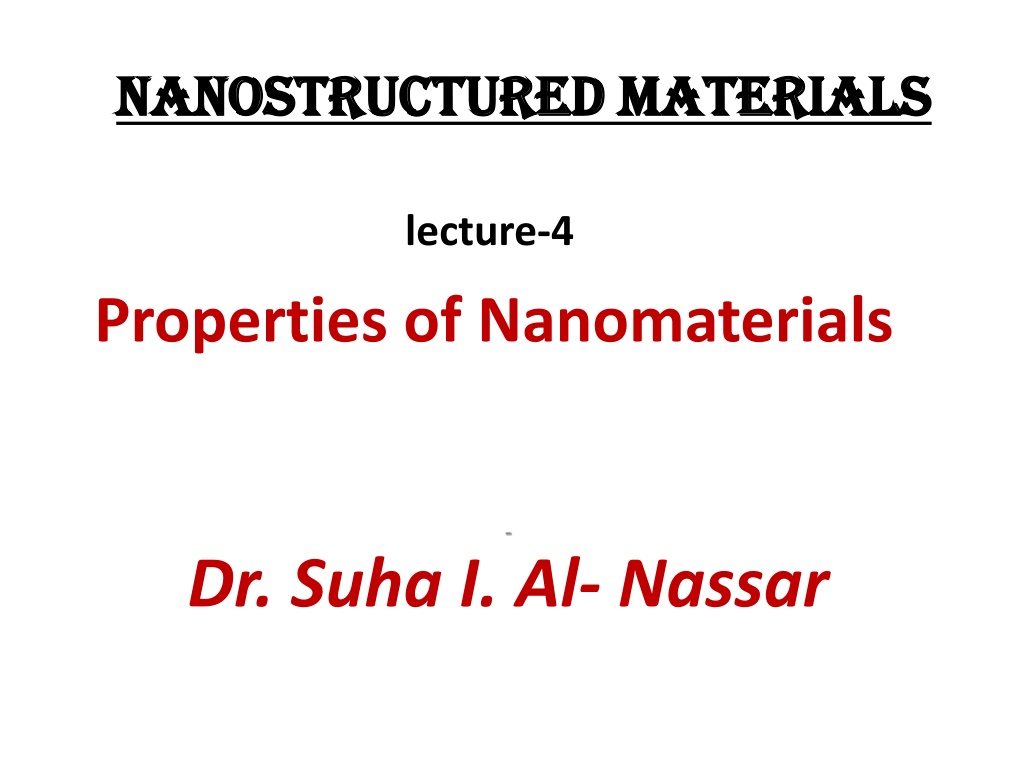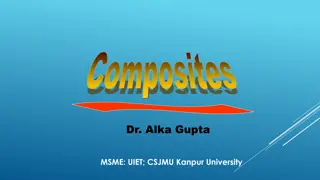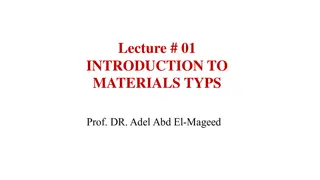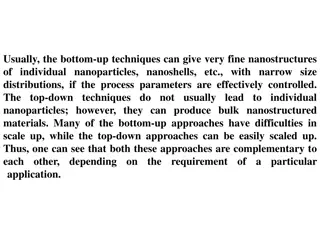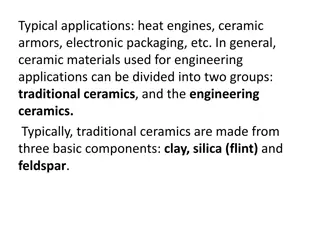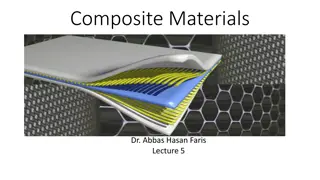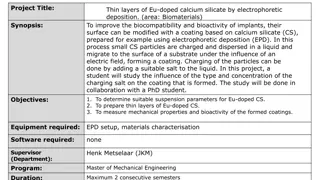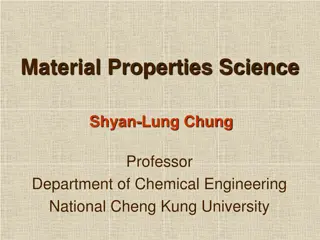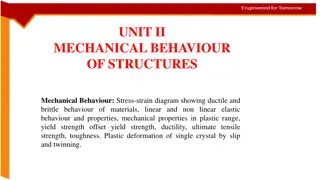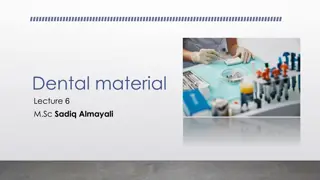Understanding Mechanical Properties of Nanostructured Materials
Nanostructured materials exhibit unique mechanical properties due to factors like grain boundary structure and dislocation movement. Reduction in grain size can enhance strength and hardness while reducing ductility. Nanomaterials may reach theoretical strength levels, significantly higher than single crystals. Small sizes reduce imperfections, improving surface and internal perfection, leading to enhanced mechanical properties like increased strength and surface perfection.
Download Presentation

Please find below an Image/Link to download the presentation.
The content on the website is provided AS IS for your information and personal use only. It may not be sold, licensed, or shared on other websites without obtaining consent from the author. Download presentation by click this link. If you encounter any issues during the download, it is possible that the publisher has removed the file from their server.
E N D
Presentation Transcript
Nanostructured Materials Nanostructured Materials lecture-4 Properties of Nanomaterials Dr. Suha I. Al- Nassar
Properties of Nanomaterls Nanomaterials display optical, thermal, magnetic, catalytic, mechanical and magnetic properties that differ significantly not only from those of molecular units but also from those of macroscopic system. 1- Mechanical properties The important factors that determine the mechanical properties of nanostructured materials are the grain boundary structure, boundary angle, boundary sliding and movement of dislocations. The large amount of grain boundaries in bulk materials made of nanoparticles allows grain boundary sliding reaches to high plasticity. In plastic deformation, grain size reduction can yield improvements in strength, hardness and reduce ductility due to new grain boundaries, which act as effective barriers to dislocation motion. Mechanical properties of nanomaterials may reach the theoretical strength, which are one or two orders of magnitude higher than that of single crystals in the bulk form. The enhancement in mechanical strength is simply due to the reduced probability of defects .
Mechanical Properties Mechanical Properties Typically Improve! The calculated strength of perfect crystals exceeds that of real ones by two or three orders of magnitudes. A lot of work has been done on whiskers that approach the theoretical limit first demonstrated by Herring and Galt in 1952 if diameter are less than 10 um. Note: The enhancement starts in the micrometer scale which is different from other size dependent properties. Two possible mechanisms have been proposed to explain the enhanced strength of nanowires or nanorods (in reality with diameters less than 10 microns). Increased Increased Surface Perfection Internal Perfection
Mechanical Properties Increased 150 Internal Perfection Photolumine scence nm The smaller the cross-section of a whisker or nanowires, the less is the probability of finding in it any imperfections such as dislocations, micro-twins, impurity precipitates, etc Thermodynamically, imperfections in crystals are highly energetic and can be eliminated -- small sizes makes such elimination of imperfections possible Imperfections in bulk materials, such as dislocations are often created to accommodate stresses generated in the synthesis and processing of bulk materials due to temperature gradient and other inhomogeneities. Such stresses can not be excluded but are generally not as likely to exist in small structures, particularly in nanomaterials
Mechanical Properties Increased 150 Photolumine scence Surface Perfection nm In general, smaller structures have less surface defects. It is particularly true when the materials are made through a bottom-up approach. Vapor grown whiskers with diameters of 10 microns or less had no detectable steps on their surfaces by electron microscopy, whereas irregular growth steps were revealed on whiskers with diameters above 10 microns. Both mechanisms are closely related. When a whisker is grown at a low supersaturation, there is less growth fluctuation in the growth rate and both the internal and surface structures of the whiskers are more perfect. Figure 8.18 shows a typical dependence of strength on the diameter of a sodium chloride whisker and similar dependences are found in metals, semiconductors, and insulators. In the last few years, AFM and TEM have been applied for measuring the mechanical property of nanowires or nanorods. Both AFM and TEM promise some direct evidence for the mechanical behavior of nanostructures and nanomaterials.
Mechanical Properties Nanomaterials Applied Force per area before plastic deformation occurs Stronger hardness than what has been predicted by the Hall Petch Model Bulk: More Room for Deformation in bulk polycrystalline materials Hall Petch Model (no longer valid) The Hall-Petch model treats grain boundaries as barriers to dislocation motion, and thus dislocations pile up against the boundary. Upon reaching a critical stress, the dislocations will cross over to the next grain and induce yielding. d = micrometer scale grain size Hall Petch Model says the smaller the grain size the stronger the material. yield strength The model is no longer valid as you go to single crystal materials. hardness
Mechanical Properties Nanomaterials Applied Force per area before plastic deformation occurs Stronger hardness than what has been predicted by the Hall Petch Model Bulk: More Room for Deformation in bulk polycrystalline materials Hall Petch Model (no longer valid) The Hall-Petch model treats grain boundaries as barriers to dislocation motion, and thus dislocations pile up against the boundary. Upon reaching a critical stress, the dislocations will cross over to the next grain and induce yielding. d = micrometer scale grain size Hall Petch Model says the smaller the grain size the stronger the material. yield strength The model is no longer valid as you go to single crystal materials. hardness
The mechanical properties of the top layer of the list of properties benefiting from the small size of the granules and the presence of large numbers of atoms of the material in the external surfaces. For example, the hardness of the materials of the medium and the alloys increases and the strength of the load loads By minimizing the dimensions of the granules of the material and controlling the arrangement of the atoms. . For example, titanium carbide granules are used in the manufacture of cutting and drilling tools used in cutting hard objects as well as in access to oil reservoirs and groundwater lakes. By dealing with the rocks of high-hard geological strata, instead of using high-priced black diamonds, which are less specific to the properties of these new nanomaterials, nanoparticles are now as high- hardened and durable as oxides
The Zirconium aluminum is an applied field. It is used in the internal surfaces of engine cylinders to increase the life span of the engine and the protection of the engine from the rust which is exposed during the operation due to the contact of the components of the oral and especially in high temperature places, which lose the efficiency of the oils used in the cooling efficiently. The composite fissure, made up of nanoparticles that combine with other granules of ceramic materials, is one of the keys used to make aircraft and other spacecraft.
2. Magnetic Properties As other properties, the magnetic properties of nanomaterials differ from those of bulk material. Different local environment for the surface atoms in their magnetic coupling/ interaction with neighboring atoms occur because of large surface to volume ratio and this leading to the mixed volume and surface magnetic characteristic, therefore ferromagnetism of bulk materials disappears and transfers to super Para magnetism in the nanometer scale due to the huge surface energy . The smaller the granules of materials and the greater the presence of the outer surfaces, the greater the pitch. The strength of the magnet depends quantitatively on the dimensions of the dimensions of the granules of the material made magnetism, and the smaller . the granules and the increased the area of external surfaces and the presence of atoms on the surface, as the strength and effectiveness of magnets to increased.
3. Optical Properties The electronic structure of any material plays an important role on optical response of this material. In nanomaterials the electronic structure is closely related to its chemical composition, arrangement, and physical dimensions. The effect of reduced dimensionality on electronic structure has the most profound effect on the energies of valance band (the highest occupied molecular orbital) and the conduction band (the lowest unoccupied molecular orbital), therefore the transitions between these two states determine the optical emission and absorption of nanomaterials in particular, semiconductors and metals, show large changes in optical properties, such as color, as a function of particle size . The colour of a material is a function of the interaction between the light and the object. If a material absorbs light of certain wavelengths, an observer will not see these colours in the reflected light. Only reflected wavelengths reach our eyes and this makes an object appear a certain colour. For example, leaves appear green because chlorophyll, which is a pigment, absorbs the blue and red colours of the spectrum and reflects the green.
Some nanomaterials display very different optical properties, such as colour and transparency, compared to bulk materials. In fact the key contributory factor include quantum confinement of electrical carriers within nanoparticles, this behaviour can be cleared by Plasmons phenomena. Plasmons of the surface? When a metal particle is exposed to light, the oscillating electromagnetic field of the light induces a collective coherent oscillation of the free electrons (conduction band electrons) of the metal. This electron oscillation around the particle surface causes a charge separation with respect to the ionic lattice, forming a dipole oscillation along the direction of the electric field of the light. The amplitude of the oscillation reaches maximum at a specific frequency, called surface plasmon resonance (SPR). The SPR induces a strong absorption of the incident light and thus can be measured using a UV Vis absorption spectrometer.
The SPR band is much stronger for plasmonc nanoparticles (noble metal, especially Au and Ag) than other metals. The SPR band intensity and wavelength depends on the factors affecting the electron charge density on the particle surface such as :- the metal type, particle size, shape, structure, composition and the dielectric constant of the surrounding medium. From this reason, it can be easily understand the different in the colour of gold metal(for example) when the gold particles become in nanoscale. The applications based on optical properties of nanomaterials include optical detector, sensor, imaging, display, solar cell, photocatalysis, photoelectrochemistry and biomedicine.
4. Thermal Properties One of the most important thermal properties of nanomatarials is melting point, the melting point of a nanomaterials decreases sharply as the particle size reaches critical diameter usually < 5 nm. The changes in melting point occur because nanoscale materials have a much larger surface-to-volume ratio than bulk materials ,therefore they tend to be able to move easier at the lower temperature. Thus the large increases in surface energy and the change in interatomic spacing have a clear effect on thermal properties. Figure 1 shows the melting point decreases dramatically as a function of particle size gets below 5 nm .
Melting-point depression is the phenomenon of reduction of the melting point of a material with reduction of its size. This phenomenon is very prominent in nanoscale materials, which melt at temperatures lower than bulk materials. The melting temperature of a bulk material is not dependent on its size. However as the dimensions of a material decrease towards the atomic scale, the melting temperature scales with the material dimensions. The decrease in melting temperature can be on the order of tens to hundreds of degrees for metals with nanometer dimensions. Melting-point depression is most evident in nanowires, nanotubes and nanoparticles, which all melt at lower temperatures than bulk amounts of the same material. Changes in melting point occur because nanoscale materials have a much larger surface-to-volume ratio than bulk materials, drastically altering their thermodynamic and thermal properties.
Melting point depression is a very important issue for applications involving nanoparticles. Nanoparticles are currently used or proposed for prominent roles in catalyst, sensor, medicinal, optical, magnetic, thermal, electronic, and alternative energy applications. Nanoparticles must be in the solid state to function at elevated temperatures in several of these applications. Two techniques allow measurement of the melting point of nanoparticle. The first one is by electron beam of the transmission electron microscope (TEM) which can be used to melt nanoparticles.The melting temperature is estimated from the beam intensity, while changes in the diffraction conditions to indicate phase transition from solid to liquid. This method allows direct viewing of nanoparticles as they melt, making it possible to test and characterize samples with a wider distribution of particle sizes. The second one is by developed nanocalorimeters that directly measure the enthalpy and melting temperature of nanoparticles
another important property of thermal properties is Thermal Conductivity in Nanomaterials. In general, increasing the number of grain boundaries will enhance phonon scattering at the disordered boundaries, resulting in lower thermal conductivity. Thus, nanocrystalline materials would be expected to have lower thermal conductivity compared to conventional materials. However, as the grain sizes assume nanodimensions, their size becomes comparable to the mean free paths of phonons that transport thermal energy. Thus, nanomaterials can show widely different properties compared to coarse-grained materials, due to the photon confinement and quantization effects of photon transport. It has been observed that in addition to the grain size, the shape also has an influence on the thermal properties of nanomaterials. For example, one-dimensional nanowires may offer ultralow thermal conductivities. In nanowires, quantum confinement of phonons in 1D can result in additional polarization modes compared to that observed in bulk solids
The strong phononphonon interactions and enhanced scattering at grain boundaries result in a significant reduction in thermal conductivity of nanostructures. Silicon nanowires are known to exhibit thermal conductivity at least about two orders of magnitude smaller than that of bulk silicon. In contrast, the tubular structures result in an extremely high thermal conductivity along the axial direction. However, high anisotropy in their heat transport property is observed, making the thermal transport direction dependent. In multilayered coatings, many collective modes of phonon transport may appear besides the phonon modes in each single layer; when the phonon coherence length becomes comparable to the thickness of each layer, the transport properties are significantly influenced. When the mean free path of phonons spans multiple interfaces, the phonon dispersion relation is modified, resulting in enhanced scattering due to decrease in phonon group velocity.
Further, if the multilayer is designed to have a superlattice structure, and alternate films have a large mismatch in the phonon dispersion relations, it is possible that phonons in a certain frequency range may not propagate to the neighbouring layers unless there are mode conversions at the interface. Also, the presence of interface dislocations and defects can contribute to enhanced boundary scattering. All these factors can contribute to the lower thermal conductivity of multilayered nanostructured films. The use of a nanofluid to enhance thermal transport is another promising application of the thermal properties of nanomaterials. Nanofluids represent the class of liquids that have a stable colloidal dispersion of nanoparticles distributed uniformly in the medium. It has been observed that dispersion of a wide variety of nanoparticles of oxides, nitrides, metals, metal carbides and nanofibres, such as single- and multi-walled carbon nanotubes, can significantly enhance the thermal conductivity of the fluid.
To obtain stable colloidal suspensions, the particle size should normally be in the range of 1 100 nm and an anti-coagulant may also be added to enhance the stability of the nanofluid. The idea of enhancing the thermal conductivity of liquids using solid dispersions is not completely new. This is because we know that solids in general have much higher thermal conductivity than liquids and gases. Thus, it is obvious that thermal conductivity of a fluid can be enhanced by having particles of better heat transport properties dispersed in it. However, in the early years of development of particle dispersed fluids, microcrystalline dispersoid particles were used.
5. Electrical properties: The properties like conductivity or resistivity are come under category of electrical properties. The examples of the change in electrical properties in nanomaterials are: 1) Conductivity of a bulk or large material does not depend upon dimensions like diameter or area of cross section and twist in the conducting wire etc. However it is found that in case of carbon nanotubes conductivity changes with change in area of cross section. 2) It is also observed that conductivity also changes when some shear force (in simple terms twist) is given to nanotube. 3) Conductivity of a multiwalled carbon nanotube is different than that of single nanotube of same dimensions. 4) The carbon nanotubes can act as conductor or semiconductor in behaviour but we all know that large carbon (graphite) is good conductor of electricity.
In electrically conducting carbon nanotubes, only one electron wave mode is observed which transport the electrical current. As the lengths and orientations of the carbon nanotubes are different, they touch the surface of the mercury at different times, which provides two sets of information: (i) The influence of carbon nanotube length on the resistance; and (ii) The resistances of the different nanotubes. There are three categories of materials based on their electrical properties: (a) conductors; (b) semiconductors; and (c) insulator
Quantum confinement causes the energy of the band gap to increase as. Furthermore, at very small dimensions when the energy levels are quantified, the band overlap present in metals disappears and is actually transformed into a band gap. This explains why some metals become semiconductors as their size is decreased 7. Biological properties: Increase the ability of nanoparticles to take advantage of, and extract the seeds of the conflict and the biological barriers, and enhance the comparability . However, risks may be associated with environmental and health issues, safety issues and the negative effects of particles The extent to which they are currently regulated; and the transitional effects such as displacement from traditional industries and the dominance of technology products Nano; military applications such as biological weapons, and neck through nanoscale sensors, which concern defenders on privacy rights.
